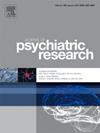高强度间歇训练对创伤后应激障碍患者血清脑源性神经营养因子的影响。
IF 3.2
2区 医学
Q1 PSYCHIATRY
引用次数: 0
摘要
背景:脑源性神经营养因子(BDNF脑源性神经营养因子(BDNF)是一种对突触可塑性和记忆形成非常重要的蛋白质。有人认为,它在创伤后应激障碍(PTSD)等精神疾病的发展过程中起着重要作用。创伤后应激障碍患者血清中的 BDNF 水平通常会下降。体育锻炼可有效提高血清中的 BDNF 水平:由于提高创伤后应激障碍患者血清 BDNF 水平的最有效运动方式尚未确定,我们比较了两种训练方案及其对 BDNF 释放的影响。我们预计,高强度训练比低强度训练(LIT)更能提高 BDNF 血清水平:40名被诊断患有创伤后应激障碍的参与者(80%为女性)被随机分配到高强度间歇训练组(HIIT)或低强度训练组(LIT)。他们接受了为期 12 天的训练。我们在干预的第一天和最后一天测量了运动前和运动后的血清 BDNF 水平。BDNF与血小板计数进行了对照:结果:在 HIIT 组中,运动后血清 BDNF 水平在运动前和运动后都有显著增加。这种增加是短暂的。在为期 12 天的训练过程中,两组的血清 BDNF 都没有增加:结论:单次 HIIT 可短暂提高创伤后应激障碍患者的血清 BDNF 水平。结论:单次 HIIT 训练可短暂提高创伤后应激障碍患者的血清 BDNF 水平,但在 12 天的训练过程中,HIIT 和 LIT 均未提高血清 BDNF 水平。本文章由计算机程序翻译,如有差异,请以英文原文为准。
Effects of high intensity interval training on serum brain-derived neurotrophic factor in individuals with PTSD
Background
Brain-derived neurotrophic factor (BDNF) is a protein important for synaptic plasticity and formation of memory. It is suggested to play an important role in the development of psychiatric disorders like post-traumatic stress disorder (PTSD). Individuals with PTSD usually show decreased BDNF levels in serum. Physical exercise has shown to be effective in increasing serum BDNF levels.
Objective
As the most beneficial form of exercise to raise serum BDNF levels in individuals with PTSD is yet to be determined, we compared two training protocols and their effects on BDNF release. We expected that a training with higher intensity increases BDNF serum levels more than a low intensity training (LIT).
Method
40 participants (80% female) diagnosed with PTSD were randomized to either high-intensity interval training (HIIT) or a low intensity training group (LIT). They underwent a 12-day training period. We measured serum BDNF levels pre- and post-exercise on first and last intervention day. BDNF was controlled for platelet counts.
Results
In the HIIT group there was a significant increase in serum BDNF post-exercise on both days measured, respectively when controlled for platelets. The increase was transient. Both groups did not show an increase in serum BDNF over the course of the 12-day training period.
Conclusion
A single session of HIIT raised serum BDNF levels in individuals with PTSD transiently. Neither HIIT nor LIT raised serum BDNF levels over the course of 12 days.
求助全文
通过发布文献求助,成功后即可免费获取论文全文。
去求助
来源期刊

Journal of psychiatric research
医学-精神病学
CiteScore
7.30
自引率
2.10%
发文量
622
审稿时长
130 days
期刊介绍:
Founded in 1961 to report on the latest work in psychiatry and cognate disciplines, the Journal of Psychiatric Research is dedicated to innovative and timely studies of four important areas of research:
(1) clinical studies of all disciplines relating to psychiatric illness, as well as normal human behaviour, including biochemical, physiological, genetic, environmental, social, psychological and epidemiological factors;
(2) basic studies pertaining to psychiatry in such fields as neuropsychopharmacology, neuroendocrinology, electrophysiology, genetics, experimental psychology and epidemiology;
(3) the growing application of clinical laboratory techniques in psychiatry, including imagery and spectroscopy of the brain, molecular biology and computer sciences;
 求助内容:
求助内容: 应助结果提醒方式:
应助结果提醒方式:


